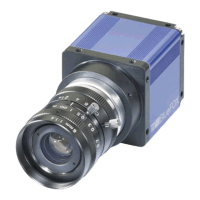146
8. Navigate to the int I2COperationExecute( void ) function (2). Click on the 3 dots next to the function name
or right-click on the command and then select Execute from the context menu to send the current message
to the I2C device.
9. The I2COperationStatus property (3) will display if the operation was successful.
10. On success, the data is now displayed in the I2CBuffer property (5). This value is a hexadecimal number
and needs to be interpreted depending on the I2C device.
Note
The following I2C addresses will be blocked for access from an application:
i2c address range affected devices
0x20-0x3F all mvBlueFOX devices
0x66-0x67 all mvBlueFOX devices
0x90-0x91 mvBlueFOX-200w only
0xA0-0xA3 all mvBlueFOX devices
0xA6-0xA7 all mvBlueFOX devices
0xBA-0xBB mvBlueFOX-202a and mvBlueFOX-205 only
1.18.6.1.3 Programming the I2C interface The following lines of source code are meant to give an overview of
the possibilities of the I2CControl class.
I2CControl i2cc( pBF ); // assuming ’pBF’ to be a valid ’Device
*
’ instance to an mvBlueFOX device
if( i2cc.I2COperationMode.isValid() )
{
// direct property access
i2cc.I2CBufferLength.write( 0 );
i2cc.I2COperationMode.write( I2ComRead );
assert( ( i2cc.I2COperationExecute.call() == DMR_INVALID_PARAMETER ) && "Unexpected driver behaviour" );
assert( ( i2cc.I2COperationStatus.read() == I2CosNotEnoughData ) && "Unexpected driver behaviour" );
i2cc.I2CBufferLength.write( 1 );
// assuming we write to an invalid address
assert( ( i2cc.I2COperationExecute.call() == DMR_EXECUTION_FAILED ) && "Unexpected driver behaviour" );
assert( ( i2cc.I2COperationStatus.read() == I2CosFailure ) && "Unexpected driver behaviour" );
i2cc.I2COperationMode.write( I2ComWrite );
i2cc.I2CBuffer.writeBinary( string() );
assert( ( i2cc.I2COperationExecute.call() == DMR_INVALID_PARAMETER ) && "Unexpected driver behaviour" );
assert( ( i2cc.I2COperationStatus.read() == I2CosNotEnoughData ) && "Unexpected driver behaviour" );
{
char binData[2] = { ’A’, ’B’ };
i2cc.I2CBuffer.writeBinary( string(binData, sizeof(binData)) );
}
// assuming we write to an invalid address
assert( ( i2cc.I2COperationExecute.call() == DMR_EXECUTION_FAILED ) && "Unexpected driver behaviour" );
assert( ( i2cc.I2COperationStatus.read() == I2CosFailure ) && "Unexpected driver behaviour" );
// Write some data. This will only work if several conditions are met:
// - there is a device that can be written to at address 0xA6
// - the sub-address 0x04 is valid
// - the device is designed to work with 8 bit sub-addresses
// - the device can deal with 9 bytes in a single command
i2cc.I2CDeviceAddress.write( 0xA6 );
i2cc.I2CDeviceSubAddress.write( 0x04 );
i2cc.I2CDeviceSubAddressWidth.write( 8 );
{
char binData[9] = { ’D’, ’E’, ’A’, ’D’, ’ ’, ’B’, ’E’, ’E’, ’F’ };
i2cc.I2CBuffer.writeBinary( string( binData, sizeof( binData ) ) );
}
i2cc.I2COperationMode.write( I2ComWrite );
int I2COperationExecuteResult = i2cc.I2COperationExecute.call();
if( I2COperationExecuteResult != DMR_NO_ERROR )
{
printf( "’I2COperationExecute’ write failed. Return value: %s(%d).\n", ImpactAcquireException::getErrorCodeAsString( I2COperationExecuteResult ).c_str(), I2COperationExecuteResult );
MATRIX VISION GmbH

